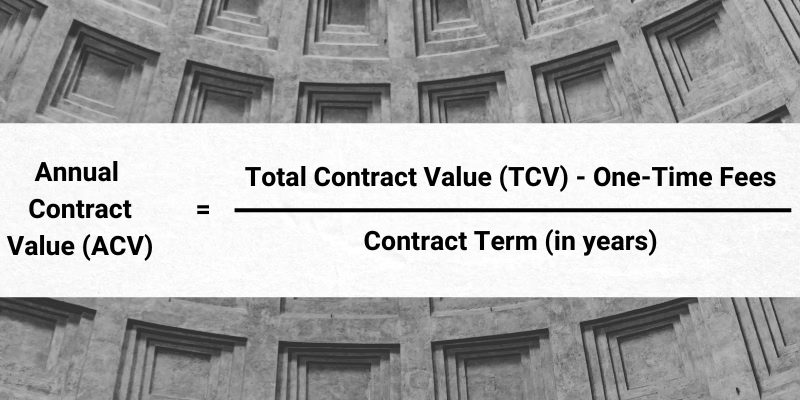What is Annual Contract Value (ACV) in Sales? A Guide With Examples

If you’re navigating the world of tech sales, chances are you’ve come across the term Annual Contract Value (ACV). But what exactly does it mean, and why is it so pivotal for SaaS companies and sales professionals?
This guide breaks down the concept of ACV in a simple, actionable way. You’ll learn not only what ACV is but also how to calculate it and why it matters. We’ll wrap up with real-world examples of ACVs from tech sales, helping you visualize its application and impact.
What is Annual Contract Value (ACV)?
At its core, Annual Contract Value (ACV) is a metric that represents the average yearly revenue generated from a customer’s contract, minus the one-time fees. It’s particularly relevant for businesses operating with subscription models, such as SaaS companies, where customers pay for services on an ongoing basis.
ACV is more than just a number — it’s a snapshot of the recurring revenue a single customer can bring in over a year. ACV is calculated on an annualized basis, even if customers sign contracts for longer or shorter periods.
ACV vs. Total Contract Value (TCV): What’s the Difference?
Before we move further, it’s important to differentiate ACV from its close cousin, Total Contract Value (TCV). While TCV measures the entire value of a contract over its lifetime, ACV hones in on the yearly value.
For example:
- If a customer signs a three-year contract worth $15,000, the TCV is $15,000.
- However, the ACV is $5,000 ($15,000 ÷ 3 years).
Understanding this distinction is crucial because ACV focuses more on annual recurring revenue, which is a key metric for SaaS companies monitoring predictable income streams.
How to Calculate Annual Contract Value
The formula for calculating ACV is straightforward:
ACV = (Total Contract Value – One Time Fees) ÷ Contract Term (in years)
However, if your contracts vary in structure or include additional elements like setup fees, the calculation may need slight adjustments. For instance:
- Recurring Revenue: Considers only the ongoing subscription fees.
- One-Time Fees: Initial charges like setup fees are excluded from ACV and considered part of the TCV instead.
Here’s an example:
- Scenario 1: A company signs a customer on a 2-year contract worth $20,000 (including a one-time setup fee of $2,000). The ongoing subscription value is $9,000 per year.
- TCV = $20,000
- ACV = $9,000 (excluding the one-time fee)
Calculations like these ensure ACV remains a consistent measure of annual recurring revenue.
Why is ACV Important in Sales?
The significance of ACV stretches far beyond being a simple metric. Here’s why it’s a focal point for SaaS companies and sales professionals:
1. Tracks Revenue Growth
ACV provides a clear view of how much revenue your subscriptions generate on an annual basis. Companies can track changes in ACV over time to gauge their growth trajectory, which helps departments align strategies for scaling.
2. Guides Sales Strategies
Understanding ACV helps sales teams prioritize their time on accounts. Bigger ACVs typically mean bigger revenues, so a high-earning SaaS might focus on enterprise clients with larger contracts.
Conversely, companies with smaller ACVs could optimize costs or automate sales processes for a sustainable business model.
3. Supports Forecasting
Knowing your average ACV allows for more predictable revenue forecasting. When combined with other metrics like Customer Lifetime Value (CLV) and Customer Acquisition Cost (CAC), ACV paints a detailed picture of profitability.
Examples of ACVs in Tech Sales
Now that we’ve covered theory, let’s look at practical examples of ACVs to help you see how this metric works in real-world tech sales scenarios:
Example 1: Small Business SaaS
Scenario: An accounting software company for small businesses offers a subscription plan worth $500 per month, with a contract length of 12 months.
- Total Contract Value (TCV): $500 x 12 = $6,000
- Annual Contract Value (ACV): TCV ÷ Contract Term = $6,000 ÷ 1 = $6,000
Since this is a 1-year contract, the ACV is the same as the TCV here.
Example 2: Enterprise SaaS with Multi-Year Contracts
Scenario: An enterprise CRM company sells a 3-year contract to a corporate client for $155,000, with a $5,000 one-time setup fee.
- Subscription Revenue: $150,000 (excluding setup fee)
- ACV Calculation: $150,000 ÷ 3 = $50,000 per year
The setup fee doesn’t impact the ACV, so the focus remains on the recurring value.
Example 3: Dynamic Pricing Structures
Scenario: A cloud storage provider offers discounts for longer commitments. They sign one client on a 2-year term at $10,000 annually and another client on a 3-year contract at $8,000 annually.
- Client 1 (2-Year Contract): TCV = $20,000; ACV = $10,000
- Client 2 (3-Year Contract): TCV = $24,000; ACV = $8,000
Though Client 2 represents a higher TCV, Client 1 generates more annual revenue, emphasizing the nuance of ACV.
Example 4: High-Ticket Sales
Scenario: A cybersecurity SaaS company seals a deal for $500,000 for a 5-year contract with comprehensive add-ons, but the recurring subscription cost is $90,000 per year.
- ACV Calculation: $90,000 (recurring revenue only, since add-ons are upfront costs)
Even with high TCVs, ACVs help sales teams monitor recurring income consistency.
Tips for Maximizing Your ACV
Increasing ACV often comes down to driving more value for customers. Here are a few strategies SaaS companies can consider:
- Upselling and Cross-Selling: Encourage customers to upgrade their plans or purchase complementary services.
- Customized Enterprise Plans: Offer tailored packages for larger accounts to secure higher contract values.
- Focusing on Retention: Loyal, satisfied customers are more likely to renew contracts and commit to multi-year agreements.
By strategically targeting these areas, SaaS providers can drive long-term growth and stability.
What’s Next? Unlock Business Growth with Precision Metrics
Annual Contract Value isn’t just a number — it’s a tool that empowers SaaS companies to make smarter decisions. Whether you’re analyzing revenue streams, crafting strategies for scaling, or identifying ideal customer segments, ACV provides valuable insights that align everyone from your sales team to your leadership.
Want to learn more about crunching numbers that matter most in tech sales? Explore the rest of the Tech Sales Temple Dictionary for more resources designed to elevate your performance. Also make sure to check out our Tech Sales Temple Community Forum to connect with other professionals.
